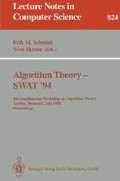Abstract
The communication power of the one-way and two-way edge-disjoint path modes for broadcast and gossip is investigated. The complexity of communication algorithms is measured by the number of communication steps (rounds). The main results achieved are the following:
-
1.
For each connected graph G n of n nodes, the complexity of broadcast in G n, B min(Gn), satisfies [log2 n]≤B min(G n)≤[log2 n]+1. The complete binary trees meet the upper bound, and all graphs containing a Hamiltonian path meet the lower bound.
-
2.
For each connected graph G n of n nodes, the one-way (two-way) gossip complexity R(G n) (R 2(G n)) satisfies
$$\begin{gathered}\left\lceil {\log _2 n} \right\rceil \leqslant R^2 (G_n ) \leqslant 2 \cdot \left\lceil {\log _2 n} \right\rceil + 1, \hfill \\1.44...\log _2 n \leqslant R(G_n ) \leqslant 2 \cdot \left\lceil {\log _2 n} \right\rceil + 2. \hfill \\\end{gathered}$$. All these lower and upper bounds are tight.
-
3.
All planar graphs of n nodes and degree h have a two-way gossip complexity of at least 1.5log2 n−log2log2 n−0.5log2 h−2, and the two-dimensional grid of n nodes has the gossip complexity 1.5log2 n−log2log2 n±O(1), i.e. two-dimensional grids are optimal gossip structures among planar graphs. Similar results are obtained for one-way mode too.
Moreover, several further upper and lower bounds on the gossip complexity of fundamental networks are presented.
This work was partially supported by grants Mo 285/4-1, Mo 285/9-1 and Me 872/6-1 (Leibniz Award) of the German Research Association (DFG), and by the ESPRIT Basic Research Action No. 7141 (ALCOM II).
This author was partially supported by SAV Grant No. 88 and by EC Cooperation Action IC 1000 Algorithms for Future Technologies.
This author was supported by the Ministerium für Wissenschaft und Forschung des Landes Nordrhein-Westfalen.
Preview
Unable to display preview. Download preview PDF.
References
K. Diks, H.N. Djidjev, O. Sýkora, I. Vrťo, ”Edge separators of planar and outerplanar graphs with applications”, Journal of Algorithms 14 (1993), pp. 258–279.
S. Even, B. Monien, ”On the number of rounds necessary to disseminate information”, Proc. 1st ACM Symp. on Parallel Algorithms and Architectures (SPAA'89), 1989, pp. 318–327.
A.M. Farley, “Minimum-Time Line Broadcast Networks”, Networks 10 (1980), pp. 59–70.
R. Feldmann, J. Hromkovic, S. Madhavapeddy, B. Monien, P. Mysliwietz, ”Optimal algorithms for dissemination of information in generalized communication modes”, Proc. Parallel Architectures and Languages Europe (PARLE'92), Lecture Notes in Computer Science 605, Springer Verlag 1992, pp. 115–130.
J. Hromkovič, C. D. Jeschke, B. Monien, ”Optimal algorithms for dissemination of information in some interconnection networks (extended abstract)”, Proc. MFCS'90, Lecture Notes in Computer Science 452, Springer Verlag 1990, pp. 337–346.
J. Hromkovič, R. Klasing, B. Monien, R. Peine, “Dissemination of Information in Interconnection Networks (Broadcasting and Gossiping)”, manuscript, University of Paderborn, Germany, Feb. 1993, to appear as a book chapter in: F. Hsu, D.-Z. Du (Eds.), Combinatorial Network Theory, Science Press & AMS, 1994.
J. Hromkovič, R. Klasing, E.A. Stöhr, ”Gossiping in vertex-disjoint paths mode in interconnection networks”, Proc. 19th Int. Workshop on Graph-Theoretic Concepts in Computer Science (WG '93), Lecture Notes in Computer Science, Springer Verlag 1993, to appear.
J. Hromkovič, R. Klasing, E.A. Stöhr, H. Wagener, ”Gossiping in Vertex-Disjoint Paths Mode in d-Dimensional Grids and Planar Graphs”, Proc. of the First Annual European Symposium on Algorithms (ESA '93), Lecture Notes in Computer Science 726, Springer Verlag 1993, pp. 200–211.
D.W. Krumme, G. Cybenko, K.N. Venkataraman, ”Gossiping in minimal time”, SIAM J. Comput. 21 (1992), pp. 111–139.
R. Klasing, B. Monien, R. Peine, E. Stöhr, ”Broadcasting in Butterfly and DeBruijn networks”, Proc. STACS'92, Lecture Notes in Computer Science 577, Springer Verlag 1992, pp. 351–362.
W. Knödel, ”New gossips and telephones”, Discrete Math. 13 (1975), p. 95.
F.T. Leighton, “Introduction to Parallel Algorithms and Architectures: Array, Trees, Hypercubes”, Morgan Kaufmann Publishers (1992).
Author information
Authors and Affiliations
Editor information
Rights and permissions
Copyright information
© 1994 Springer-Verlag Berlin Heidelberg
About this paper
Cite this paper
Hromkovič, J., Klasing, R., Unger, W., Wagener, H. (1994). Optimal algorithms for broadcast and gossip in the edge-disjoint path modes. In: Schmidt, E.M., Skyum, S. (eds) Algorithm Theory — SWAT '94. SWAT 1994. Lecture Notes in Computer Science, vol 824. Springer, Berlin, Heidelberg. https://doi.org/10.1007/3-540-58218-5_20
Download citation
DOI: https://doi.org/10.1007/3-540-58218-5_20
Published:
Publisher Name: Springer, Berlin, Heidelberg
Print ISBN: 978-3-540-58218-2
Online ISBN: 978-3-540-48577-3
eBook Packages: Springer Book Archive

